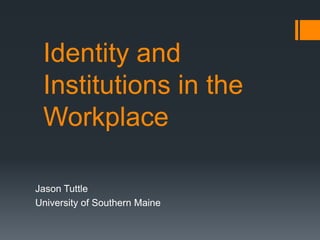
Identity and Intersectionality in the Workplace
- 1. Identity and Institutions in the Workplace Jason Tuttle University of Southern Maine
- 2. Identity Discovering the self and the other via the workplace
- 3. The Birth of Intersectionality Intersctionality, the idea that rather than being the sum of various identity parts we are instead the multiplicative of various identites, was first developed in the workplace.
- 4. The notion of intersectionality came about primarily because African-American Women found themselves the victims of not only sexual discrimination but racial discrimination as well. So their experiences differed from African-American males and Caucasian Females and thusly their identity could not be simply lumped in with members of those demographics.
- 5. “ A man is not a real man unless he is gainfully employed (202)” This quote appearing in the text, Communicating Gender Diversity, has far reaching implications. It implies that men who reach out and ask for help from social services like unemployment benefits are somehow emasculated. This is not only untrue and unfair to men but to women as well as it suggests that asking for help is something only women do.
- 6. The masculine makeup of the abstract worker Defransisco and Palczewski write, “ a vision of the abstract worker persists-a bodiless, sexless, emotionless worker who does not procreate. This sex and gender neutral worker is not actually neutral but is instead a man.(208)” Think about the word worker, what do you picture in your mind?
- 7. The Empowerment and Resistance of African-American Women At the beginning of this section I discussed the emergence of intersectionality as Now lets end this section response to the unique by discussing the five experiences they have ways Patricia had in the workplace Parker(2003) identified as ways that African- American women have resisted the practices that brought about intersectionality in the first place
- 8. The five ways Parker identified are: 1. Developing and using Voice 2. Being Self-defined 3. Being Self-determined 4. Connecting to and Building Community 5. Seeking Spirituality and Regeneration
- 9. Institution The framework in which we exist
- 10. Work is Ritualistic As the authors allude to work is inherently ritualistic despite the nature of work shifting from agriculture to service more than 25% of the population still work the Monday-Friday 9 to 5 shift. Even those whose work schedules do not fit this dynamic still view work as a daily ritual: the commute, the giant cup of coffee, getting the kids up and dressed. Work is an institution in our lives because our lives tend to revolve around the hours we spend doing work whether paid or unpaid.
- 11. The Public and Private Dichotomy of Work and Family Like the previous slide stated, work is a constant institution in our lives that dominates much of our time This has a great effect on the choices we make regarding work and family The authors cite Arlie Hochschild’s 1997 study which found, “that the rapidly increasing time stress in U.S. culture induces more persons to choose work over family because of the rewards work promises(203)”
- 12. The Origin of Power Imbalances at the Workplace Begin in the classroom…
- 13. Are Teachers and Guidance Counselors to Blame? Parker(2003) thinks so when she writes that teachers and guidance counselors often steer people, African-American women in particular, towards occupations they feel are more attainable for them and away from the occupations they spent their childhood dreaming about
- 14. Care Work: Job Segregation Manifest
- 15. What is Care Work Sociologist Mignon Duffy (2005) defines care work to include domestic service, health care, child care, teaching, food preparation and cleaning services(210) It has been historically overrepresented as being the segmented part of labor occupied by women and more prominently by African-American women. The authors point to the fact that with the advent of globalization the segregation in the care work sector has grown beyond the borders of the united states
- 16. The Intersection of Care Work, Job Segregation and Race The idea of job segregation Defransisco and Palczewski still very much permeates (2007) broach the subject by our way of thinking. When writing, “White women assume someone says the word the public face of care work, firefighter we as a society populating those jobs that call almost immediately picture for the most interaction with a white male. Conversely others, that are more when someone says nurse professionalized, and that pay we do the same process more. In contrast, women of but picture a white female. color are disproportionately represented in the dirty, back room jobs such as maids and kitchen workers(210)”
- 17. Works Cited DeFrancisco, Victoria L., and Catherine Helen Palczewski. Communicating gender diversity: a critical approach. Los Angeles: Sage Publications, 2007. Print.